Yashica 35mm Rangefinder Chronology & Specifications
Featured are the Electro 35, Yashica G, GS, GSN, GTN, GL, MG-1 and CC.
There are so many Yashica Electro 35 Rangefinder cameras on offer on the web, often with little in their description to differentiate them. Many of these offerings have supporting pictures of dismal quality or are partially cloaked in their cases. Site visitor Lindsey Harris, suggested that a chronology of these cameras would be useful, and kindly provided a sketch, which has been expanded upon below
....the original Model Yashica Electro 35 was introduced in 1966. It is shown here in the brushed satin chrome finish. This model was also available in a black enamel version, 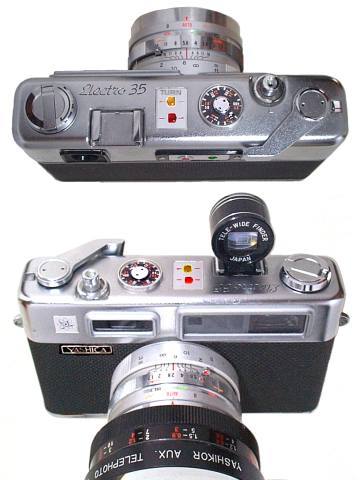 which was emblazoned on the lower right front with the emblem "Professional". The front view is depicted with the optional Tele Adapter and viewfinder. Two demarcation lines appear in this clip-on finder which show the field of view for the Tele or Wide Adapter. This camera has a battery powered aperture preferred automatic exposure system. The ASA range is from 12 to 400. To set the film speed for the automatic exposure control system, a dial which has both ASA and DIN settings is rotated to the required indicator. This round scale has a transparent plastic cover with a dimple that may have been designed to act as a magnifier, but does nothing on my example. Subsequent models only have the prevailing ASA standard on the scale and no protective dial cover. An ASA to DIN conversion table was printed inside the back door of some of the later models.
which was emblazoned on the lower right front with the emblem "Professional". The front view is depicted with the optional Tele Adapter and viewfinder. Two demarcation lines appear in this clip-on finder which show the field of view for the Tele or Wide Adapter. This camera has a battery powered aperture preferred automatic exposure system. The ASA range is from 12 to 400. To set the film speed for the automatic exposure control system, a dial which has both ASA and DIN settings is rotated to the required indicator. This round scale has a transparent plastic cover with a dimple that may have been designed to act as a magnifier, but does nothing on my example. Subsequent models only have the prevailing ASA standard on the scale and no protective dial cover. An ASA to DIN conversion table was printed inside the back door of some of the later models.
A major Yashica innovation was a unique automatic all electronic step-less shutter, the speed of which is controlled by an Electro-Magnet. This gave rise to the model designation “Electro”. This technology is shared by some of the Polaroid Land cameras. In 1960 the Polaroid Land 120 made it's debut.... it was manufactured in Japan by Yashica.
The correct exposure is determined by turning the aperture ring until neither the red or amber lamps are lit. These are visible both on the top of the camera and in the view-finder. A small arrow visible next to the lamps on the top plate, indicates the direction in which the aperture ring must be turned in order to achieve the correct exposure range. It also warns when exposures time will be so long, that a rigid mount is required. The lamp covers on the top have a directional shape. The lamps as they appear in the finder however were round. Among the later design changes, having the shape of these lamps appear as arrows in the finder, was most helpful.
Few examples of the round 'traffic light' indicators survive. All of the other cameras in the series shown on this site display Arrow Indicators in the finder.
A shutter release knob threaded to accept a cable extension trigger, and a self timer with a nominal 8 second delay, add icing to the cake of the entire series. The fixed lens is the coated legendary Yashinon DX ƒ1.7 45mm constructed with six optical elements in four groups. The lens mount is threaded to accept 55 mm accessories.
Note the spartan design of the wind lever, a carry over from the earlier classic models. It too, was made over in short order with black trim which also added to the comfort of the user, and this improvement is found in all the other models of the series shown on this site
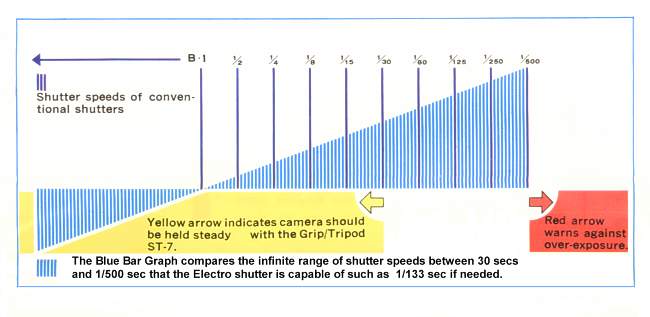 The published fully automatic exposure range capability of the system was from 30 seconds to 1/500 second as you can see in the accompanying graphic. Far longer accurate time exposures have been repeatedly reported.
The published fully automatic exposure range capability of the system was from 30 seconds to 1/500 second as you can see in the accompanying graphic. Far longer accurate time exposures have been repeatedly reported.
The camera was designed to be powered by a Mercury TR 164 / HM-4N 5.6 Volt battery. Due to the hazardous nature of mercury, these batteries are long discontinued. An adapter to use available batteries is described in the link from the Main Page of this site. It powers this model and all of the Yashica Electro G series which follow right through the GSN / GTN up to, and including the MG-1.
The success of this camera with it's
incredibly fast lens at an affordable cost, spurred the introduction of the new model G [defining Ggrade-up] in 1968. There were changes in the cosmetics and it was delivered with a new Yashinon Color designation on the lens. This was added to re-assure the public that the lens was fully Color corrected, at a time when the use of colour film exploded. There was no change to the advanced original design of the lens itself, other than an internal modification of the focus gearing.
The Model G is shown here in satin chrome finish. Starting in 1969 it was also manufactured in a black enamel finish, with the model designation GT. It can be viewed with a link to "Variations" below. The GT was supplied with an exclusive lens shade, which according to the manual, locks the setting in AUTO when mounted. It does that with all the other rangefinder cameras of this series that I have tried it on. There is no mechanical lock as such, depending instead on the fact that moving the setting under ordinary conditions is not easy, and with the lens hood mounted, one simply cannot get enough leverage to move this in error.
The tell-tale identifier of the prior Electro 35, and the G and GT versions is the sculptured recess on the bottom plate. This is an ergonomic design to enable the door to be easily grasped and opened. [See link to variations for detail images and the origin]. This design could provide a means of positive registration on a hand grip / flash bracket or other anticipated mount.
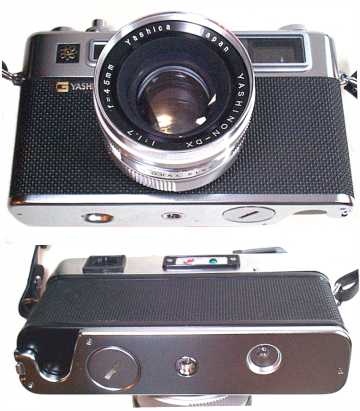
The Electro 35 and the G series viewfinders self adjust to compensate for parallax as the focus ring is turned, another welcome feature. Even the ancient Electro 35 makes focusing in the dimmest light a snap under conditions that would defy focusing an SLR. These models are readily identified, in that they have the rear door release operated by a tab mounted on the bottom of the camera. This is visible on the extreme left of the lower photo. Why this was changed is unclear because it was a trouble free design without the potential for problems that the later combo rewind / door release introduced.
The fold out rewind handle is attached to the shaft by a screw, which makes replacement of the handle spring simple.
A socket is provided on the side of the body for a flash extension cable. This is a PC socket [Photo-Flash Connector]. The term 'PC' is said to originate with Prontur Compur, the noted German shutter manufacturer who first introduced this connector, that became an industry wide standard. A cold flash shoe is top mounted. The ASA scale ranges from 12 to 500. The Battery Check Button & Indicator Lamp are framed in white. These cameras are so ideal for working in poor light conditions, that the battery test button also provided the means to light up the frame counter. The Slow / Over Indicator Lamps on the top are trimmed within a black template. The black skin is still a coarse cross hatch, which provides an excellent grip.
....the second generation Electro 35 G introduced the combo door release / rewind handle. One can only speculate that the move to a change in design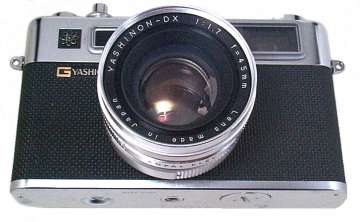 was to emulate the SLR’s which were taking over the market. There is no hot shoe and it too has a PC socket on the side for a flash synch cable. The fold down rewind handle was still attached with a screw. Notice the flat bottom plate. Viewed directly from the front, it is indistinguishable from it’s predecessor
was to emulate the SLR’s which were taking over the market. There is no hot shoe and it too has a PC socket on the side for a flash synch cable. The fold down rewind handle was still attached with a screw. Notice the flat bottom plate. Viewed directly from the front, it is indistinguishable from it’s predecessor
...the third generation Electro 35 was introduced in 1970. This was available both as the chrome satin Electro 35 GS and the Black enamel finish Electro 35 GT. Yashica also promoted this as the “Gold Mechanica”. All the electrical contact points were gold plated to increase the efficiency of the electrical current flow, and to prevent oxidation from forming which could possibly impede that flow over the course of time.
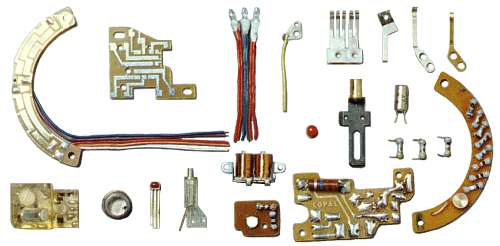
The GS retained the white template around the battery test button, while at the same time doing away with the test lamp which adjoined it in the G....Why waste battery power with two lamps, right? Pressing the test button lights up the frame counter window only. The GT switched to a black template around the battery test button, which looked so classy that it was adopted in all chrome and black succeeding models. They also heralded the switch over to a simulated leather grain skin.... 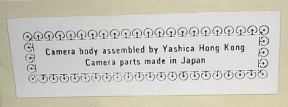 The combination film door release / rewind handle on the GS and GT are attached to the shaft with a screw. The flash shoe is still not Hot. The ASA scale has been extended to range from 25 to 1000.
The combination film door release / rewind handle on the GS and GT are attached to the shaft with a screw. The flash shoe is still not Hot. The ASA scale has been extended to range from 25 to 1000.
Interestingly, the GS and GT as well as later models can be found both made in Japan and assembled in Hong Kong with the key elements, most notably the lens and optical finder originating in Japan. The insert shows a label from the Yashica box of the Hong Kong version.
For important variations of the Black Enamel bodies, including the PRO and Accessories, go to
Variations & Accessories
. ....the fourth generation Electro 35 GSN and GTN did not appear until 1973. They were similar to the previous generation but finally received a hot shoe. The PC socket for a flash extension cable was fortunately retained. The problems resulting from overly ambitious tugging upon the door release / rewind handle, introduced the rivet head fastener. It is retained by a threaded nut but tricky to take apart to replace the leaf spring used to keep the rewind crank handle in place ....!
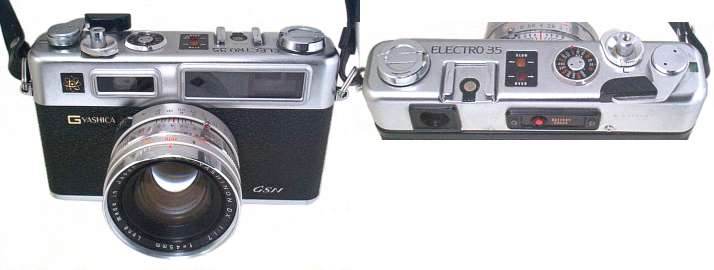
The flagship of the Yashica Rangefinders is the GTN, displayed here to illustrate the Black Finish.
 Like it's chrome partner, ASA film speeds to 1000 are supported. Mechanically it is identical to the GSN, but certain metal parts have been executed in plastic to simplify the manufacture of black parts.
Like it's chrome partner, ASA film speeds to 1000 are supported. Mechanically it is identical to the GSN, but certain metal parts have been executed in plastic to simplify the manufacture of black parts.
The Yashica Guy Updated Manual which covers the 'G' through MG-1 Models and contains additional information not found in the Yashica publications, was originally formatted as an Adobe pdf file for me by Marco Tulio Alvarenga in Brazil. Click to View or Print
Thanks to Lee Scott for the scan of the famous Yashica Electro 35mm "Moonlight" ad, which ushered in a new era of automatic exposure control. To view or print it Click Here Close Browser file to return here from that link.
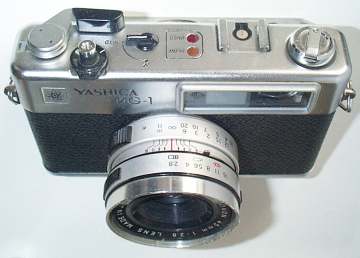
...the MG-1 is an interesting model. It appeared in 1975 and seems to have been the end of the line. The MG-1 was produced in both a chrome & black finish. The placement of the light sensor within the lens barrel made it possible as in the CC / CCN, to automatically adjust exposure with filters in place. 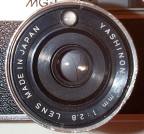 This is visible as a small circle within the top & center of the lens barrel. A feature of this arrangement which is overlooked, is the inability to obtain a correct exposure indication, if one forgets to remove the lens cap. Come on now, 'fess up....who hasn't lost a shot with an RF when a lens cap was mistakenly left on during an exposure. The lens has a maximum aperture of ƒ:2.8 with a focal length of 45mm. This highly colour corrected lens has 5 elements in 4 groups.
This is visible as a small circle within the top & center of the lens barrel. A feature of this arrangement which is overlooked, is the inability to obtain a correct exposure indication, if one forgets to remove the lens cap. Come on now, 'fess up....who hasn't lost a shot with an RF when a lens cap was mistakenly left on during an exposure. The lens has a maximum aperture of ƒ:2.8 with a focal length of 45mm. This highly colour corrected lens has 5 elements in 4 groups.

Flash synch is selected by turning a lever on the top plate.
A semi circle, terminating in a lightning bolt is visible next to the wind lever. To enable Daylight Flash fill with a Strobe, leave the lever in the Auto position. To totally disable Auto Exposure mode and set the shutter at a fixed 1/30 sec for use with Flash Bulbs, turn the lever to the Flash position. There is a Hot Shoe but no PC socket. Gone too, is a battery test feature, possibly an advantage, because compulsive battery testing runs the battery down.
The moving viewfinder mask feature found in in 'G' series is lacking in the MG-1. Instead of the finder mask moving as you focus, close-ups are aimed within an inner frame line C to compensate for the distance between the finder and the taking lens. Light passing through this dual frame line mask is projected into the finder by means of the semi transparent front surface mirror that can be seen positioned diagonally behind the mask. No linkage from the lens to the mask A is present in the MG-1, that can be clearly seen as a pin with a screw head B in the GSN / GTN and down through the original Electro G series. Thanks to Peter Smith at www.nikonsmith.com, for the MG-1 used for the tear down shots on this site.
The MG-1 decked out with a simulated leather skin. ASA / ISO Film Speed is selectable from 25 to 800, and the setting control has been placed on the lens barrel. Caution! One needs to depress this ASA setting lever in order to move it. All in all, a nifty and thrifty little camera to accompany your SLR on assignments.
......Okay.......so which was it? Did the design team take the GL designation from the luxury car of the day, [wink, wink ] or was it vice versa? There is certainly no mistaking
the "Euro" look influence by the design salons on the Continent.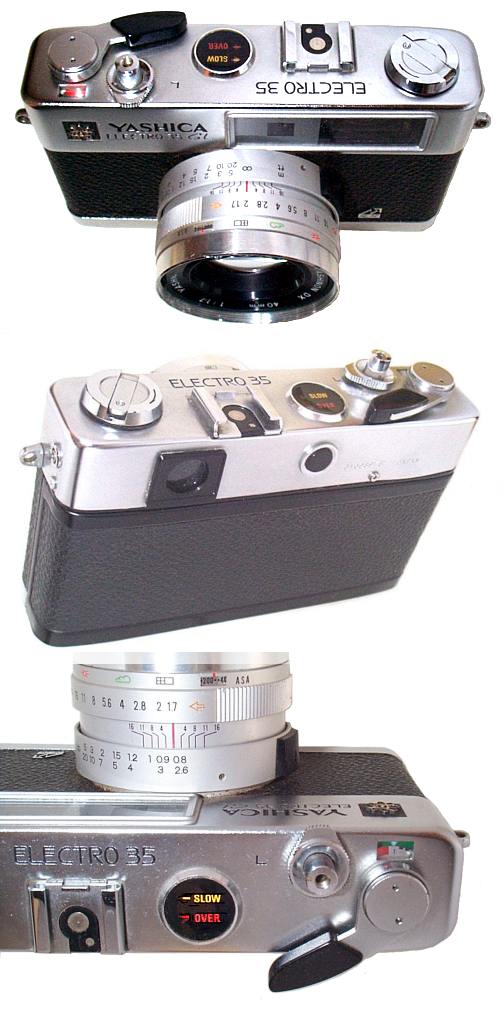
This 1973 introduction is more than a re-skin of the G series. The GL a.k.a. the AE / AF incorporates major changes from the Electro 35 GSN / MG-1 models.
Made in Japan and presumably targeted at that market it has a Yashinon DX Color ƒ1.7 40mm lens great for tight spots, but hard on the subject of portraits. The light sensor is located within the lens barrel and can therefore compensate for any filters in use. A very posh looking Slow / Over window indicates exposure balance and a larger easy to read frame counter presents a "No Film in Camera" red bar alert. This is a thoughtful addition, because the camera can be cocked and fired without film, as it does not link this function to the film sprocket. Sure the logo visible on the right front bottom designates AE for Auto Exposure, but it seems the designers got a little ahead of themselves when they partnered this with the AF designation. The First Yashica Auto Focus was still years away! This False Alarm designates "Auto Flash". Sorry guys!
If you look closely at the Hot Shoe, you will notice a third contact. When the Yashica strobe model ES-20 is mounted on the camera, with an ASA setting of 100 and the aperture is at ƒ 4.0, automatic exposure is enabled to a subject distance of 16 ft. [ 5 meters ] utilizing the camera's light sensor. The ASA setting lever when placed opposite the flash symbol, will bring the aperture to ƒ 4.0, in case you forget the setting. A side mounted PC socket is provided. The ASA speed setting spans a range from 25 to 1600. The selected speed is visible in a window on the top of the lens barrel, and the setting lever which must be depressed to change position is located at the opposite side of the barrel. A second set of levers on the lens barrel enable the self timer which has a nominal 8 seconds delay. To wind the timer, the extra flip down lever must be in the keyway position.
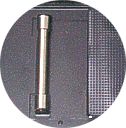 A feature exclusive to the GL and GX in the 'G' series Yashica rangefinder cameras, is a roller the the left side of the pressure plate in the door. This presumably is one more feature that sets the camera in the Luxury class, and earns it's GL designation. Other variations in design that set it apart are, the placement of the upper foam seal along the top of the camera body, with the lower seal being on the door. The door overlaps and interlocks with the latch mechanism to such a degree that no foam light & dust seal are required at that point, unlike others in the 'G' series.
A feature exclusive to the GL and GX in the 'G' series Yashica rangefinder cameras, is a roller the the left side of the pressure plate in the door. This presumably is one more feature that sets the camera in the Luxury class, and earns it's GL designation. Other variations in design that set it apart are, the placement of the upper foam seal along the top of the camera body, with the lower seal being on the door. The door overlaps and interlocks with the latch mechanism to such a degree that no foam light & dust seal are required at that point, unlike others in the 'G' series.
The tripod socket is the conventional ¼" - 20 thread but removable for use with a heavier studio standard 3/8" - 16 thread as shown in the bottom view.
The camera is a little shorter and narrower than the G GS GSN MG-1 family. Additional weight has been trimmed by removing metal wherever possible. Notice the solid rim of a prior G model shown for comparison in which the bottom plate mounting screws attach to the rim. In the GL those screws fit into posts. This profile requires the rear door to be open to remove the bottom plate which it partially covers. This weight loss program seems to have been more related to keeping the weight in line rather than a targeted reduction, as the GL is only about ¾ oz lighter, weighing in give or take, at 7.80 ozs without battery or strap. There appears to be no compromise in the reliability of the mechanism, in fact note the massive transfer bar used in the GL where it really counts.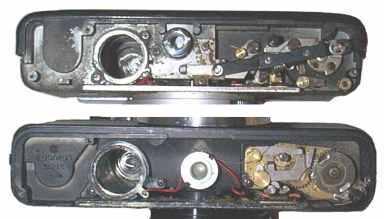
The GL is the camera at the top. Note the mounting studs required where the body has been cut down.
The Electro 35 CC appeared in 1970 and was introduced in the US at the Photo Expo 71. Just a personal observation, I think that if Tiffany designed a camera, this would be it. The Yashica CC looks, feels and handles like a serious camera.
It combines features of the MG-1 in that it has the light sensor within the lens barrel, and borrows from the design of the shutter release lock as seen in the G through GSN. The Battery Check, lights up the frame counter window.
As you can see, it does not have a hot shoe.
A cable synch socket [PC] is however provided and is visible on the top right end, as it is on the GL. A major inspiration while on the drawing boards, was the Automatic selection of 1/30 th second shutter speed, when a flash-gun is plugged into the PC socket. What must have been the "Cat's Pyjamas" in the jargon of the day, became the kiss of death. By the time it hit the market place, strobes were already in widespread use, and it's inability to synch flash at any speed, a highlight of the other Yash rangefinders, probably explains it's early demise and scarcity.
Fortunately Raoul Emin from Paris, France, found a simple fix for this problem. He writes that he noticed that the PC socket features a thin pin that pushes a copper contact behind the socket. If this pin is not pushed through, the circuit is not locked at 1/30. By just slightly engaging the plug halfway, the pin will not push the copper contact, yet the flash will still be engaged. At the end of the day without any modification, this little camera is even capable of nice fill-in flash in daylight.
The battery port is located on the back below the film advance lever and accepts a 6 Volt Lithium L544 or Alkaline A544 battery, also under some brands marked PX28A, or 4LR44, fortunately widely available. As far as we have been able to determine it was produced only as a black body.
A CCN model [ Compact Camera New ] was introduced in 1973, but does not appear to differ in any observable way other than that the shutter 's longest exposure is 8 sec vs the CC 15 sec. The ASA /ISO speed selector ranges from 25 to 500. The ƒ:1.8 35mm Color Yashinon DX lens makes this handy for taking pictures in extremely low light and tight spots. Due to the short focal length of the lens, be sure to observe the correct protocol when shooting portraits.
We would like to hear your take on this site Send us an eMail ! via this link